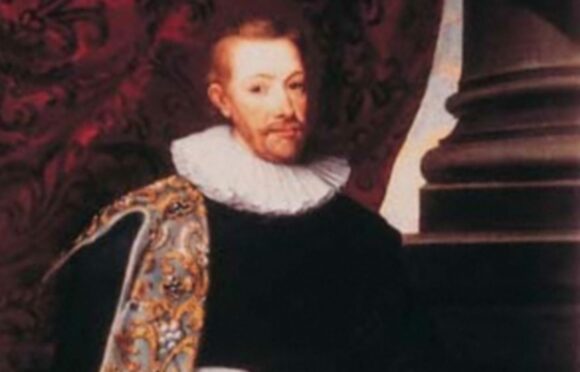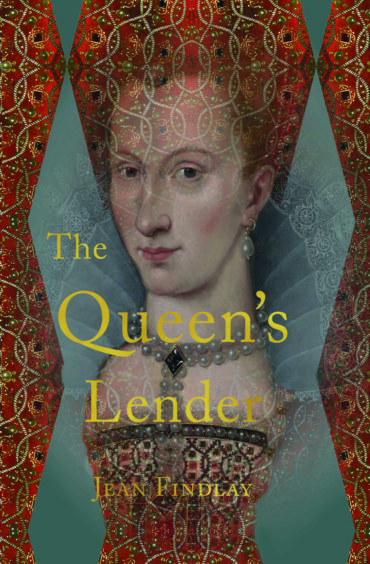
George Heriot may be most familiar today for giving his name to the school and university he founded in Edinburgh.
But he was jeweller to King James VI & I and lent his queen so much money that he became wealthier than the monarch and was known as “Jinglin’ Geordie”.
A new novel, The Queen’s Lender, traces Heriot’s fortunes from his home in Fishmarket Close in Edinburgh’s Old Town, where the canny Scot supplied luxury-loving Queen Anne with intricate jewellery she couldn’t afford by using the gems he’d sold to her as collateral for loans.
When James VI of Scotland inherited the English throne from Elizabeth I and styled himself King James I of Great Britain and Ireland in 1603, Heriot followed the court from Holyrood to London.
Through the eyes of this unassuming, plain-living man, a new novel gives an intimate view of the monarch responsible for the Union of the Crowns and who created the Union Jack.
Author Jean Findlay was inspired to write the book when she returned from living in London for 20 years to her hometown of Edinburgh in 2014, the year of the independence referendum.
“It made me think about the Union of Parliament in 1707 and the more significant Union of the Crowns in 1603. It was King James’ personal mission to create the United Kingdom, bringing together warring factions,” said Findlay.
“It was an exciting period in our history when the Scottish language and culture were transposed to England. James was a remarkable king who gave Shakespeare his first secure position as court playwright. To calm the perfidious religious tensions in the country, he commissioned the translation of the Bible. He also created the Union Jack, called after himself.”
In the novel, James and his Danish queen speak broad, vernacular Scots, some of it so earthy that it shocks the sophisticated English courtiers.
“I thought the culture clash of the two courts was interesting – the English court was very formal, and the monarch treated with deference, while the Scottish court was less hierarchical with many being able to talk to the king.
“James spoke Middle Scots and swore freely. The English thought the Scots were barbarians, but James was a cultured and educated man who spoke Latin and Greek, as well as German, Danish, Spanish and French,” said Findlay.
In the novel, Heriot and his second wife – the first drowned with their two sons when their ship was caught in a storm sailing to join her husband in London – are shocked by the extravagance and obscene wealth of the English court.
“There was a ridiculous amount of wealth on display,” said Findlay. “The courtiers were bedecked with jewels and new pieces had to be created all the time to keep up with the king and the queen. Heriot created an amazing hat jewel for James with four enormous precious stones representing the four nations.”
The author writes: “On his modest black velvet hat is a brooch of monstrous proportions carrying a huge table diamond, a big ruby to the left, two glistening diamonds cut from the Great Harry jewel given to James’ mother by Henri of France, two large pearls fixed on the head and diamonds studded around.”
When Robert Cecil, the Earl of Salisbury, James’ Chancellor and chief advisor, asks him who created the piece, James says: “My own Scots jeweller, Heriot. It is a political piece called The Mirror of Great Britain, the four precious jewels are the four kingdoms of Scotland, England, Ireland and Wales. Scotland is at the top, of course.”
When challenged that England should be at the top as it supplies the wealth, the king is quick with his response: “Aye, but we provide the brains, the leadership and the ingine (natural talent). What use a rudderless ship, however laden with riches?”
Findlay delves into James’ past to give insights into his character and what drives him.
“He had a hard childhood, taken from his mother, Mary, Queen of Scots, and brought up in Stirling Castle by the Earl of Mar. His strict tutor George Buchanan beat him and referred to his mother as ‘the Great Whore’.”
In the book, Heriot and his first wife discuss James’ bloodthirsty family history and the rumours that Mary, Queen of Scots was behind the murder of her husband and his father Lord Darnley, and how Shakespeare’s play, Hamlet, is based on these rumours.
“If folk told ye from your childhood that yer ain mither had murdered yer faither, that would punish the heart and soul,” says Heriot, whose wife replies: “And then they beheadit her, the Queen, his mither, the bonnie, bonnie Queen. There’s a play in London aboot this and set in Elsinore (where James married Anne), so we ken where the story comes fae. Aboot a Prince whose mither plots the death of his faither.”

Findlay believes that although James was brought up to despise his mother, as he matured, he felt compassion for her and how she had been treated.
“Though he was never allowed to read his mother’s letters to him, it was revealed by the Danish King, who received Bothwell’s confession, that Mary was not responsible for Darnley’s murder,” said Findlay.
“In 1612, he had her body exhumed from Peterborough Cathedral and built an ornate tomb for her in the Lady Chapel in Westminster Abbey – the most elaborate one there.”
The white marble effigy of the queen lies below an intricately carved marble canopy, with a Scottish lion at her feet.
The Latin inscription reads: “To God, the best and greatest. To her good memory, and in eternal hope. Mary Stuart, Queen of Scots … sure and certain heiress to the crown of England while she lived: mother of James, most puissant sovereign of Great Britain.”
George Heriot gives an Everyman view of James’ court and the rumours about his sexuality – the dashing George Villiers, Duke of Buckingham was thought to be his lover. James’ reign saw a flowering of the arts with writers such as Ben Jonson, Sir Francis Bacon, John Donne, the architect Inigo Jones and the Scottish poet William Drummond.
His rule oversaw the Plantation of Ulster and the colonisation of the Americas, as well as the Gunpowder Plot and Britain being reluctantly drawn into the Thirty Years’ War.
James’ obsession with demonology and witchcraft resulted in the trials and execution of “witches” accused of plotting to murder him. During his time as court goldsmith, George Heriot amassed a fortune by lending money to the Queen, and by 1609 was receiving 10% on loans to her that totalled £18,000.
His position at court meant he sold jewels to other members of the royal circle such as the Duke of Buckingham and the Earl of Somerset. In November 1620 he was granted the imposition on sugar for three years. As well as a home in St Martin-in-the-Fields, Heriot had an estate at Roehampton, Surrey.
When he died in 1624, Heriot left the bulk of his fortune – £23,625, worth of tens of millions today – to his hometown for a “hospital and school for the education, nursing and upbringing of poor orphans and fatherless children of burgesses and freemen in Edinburgh.”
It is now George Heriot’s School near Heriot’s home in the Old Town and a pub called after him, Jinglin’ Geordie. Heriot-Watt University was also formed from part of the trust.
Sir Walter Scott included Heriot in one of his novels and described him as: “A man of goodness of heart and rectitude of principle, and a person who has left the most magnificent proofs of his benevolence and charity that the capital of Scotland has to display.”
The Queen’s Lender by Jean Findlay is published by Scotland Street Press.

Enjoy the convenience of having The Sunday Post delivered as a digital ePaper straight to your smartphone, tablet or computer.
Subscribe for only £5.49 a month and enjoy all the benefits of the printed paper as a digital replica.
Subscribe © SYSTEM
© SYSTEM